An Analysis of the Deleterious Impact of the Infodemic during the COVID-19 Pandemic in Brazil: A Case Study Considering Possible Correlations with Socioeconomic Aspects of Brazilian Demography
Abstract
:1. Introduction
1.1. COVID-19 and Infodemic in Brazil
1.2. Analysis of Google Trends Infodemic
1.3. Rationale
- Trend analysis of research on infodemic terms, divided into five themes relating to the pandemic;
- Spatial Exploratory Analysis of the Brazilian states considering the quantity of researched infodemic terms relating to social and political scenarios in the country;
- Multivalued analysis based on clustering of Brazilian states considering the quantity of researched infodemic terms, internet access data, numbers of deaths, and COVID-19 cases relating to social and political scenarios in the country.
2. Materials and Methods
2.1. Data Extraction
- Denomination: coronavirus, COVID, corona, SARS;
- Origin: 5G coronavirus, bill gates + bill gates virus, Chinese virus, China virus;
- Prevention and Beliefs: no masks, no isolation, gargle, coronavirus gargle, garlic + garlic consumption + eating raw garlic is bad, coronavirus garlic, kill COVID, milk COVID;
- Treatment: chloroquine, COVID chloroquine, coronavirus chloroquine, chloroquine, chloroquine trump, chloroquine china, ivermectin, how to take ivermectin 6 mg, COVID food;
- Vaccine: alligator vaccine, Doria vaccine, vaccine kills + DNA vaccine, COVID cancer + COVID cancer vaccine, cause COVID vaccine, alcoholic drink COVID vaccine.
2.2. Data Processing
2.3. Data Analysis
3. Results
3.1. Trends Analysis of Infodemic Term Searches
3.2. Exploratory Spatial Analysis of Brazilian States
3.2.1. First Scenario—Infodemic and Variables That Illustrate Social Inequality
3.2.2. Second Scenario—Infodemic and Impact of Social Programs
3.2.3. Third Scenario—Infodemic and Public Influences
3.3. Cluster-Based Multivalued Analysis
3.3.1. First Scenario—Infodemic and Variables That Illustrate Social Inequality
3.3.2. Second Scenario—Infodemic and Impact of Social Programs
3.3.3. Third Scenario—Infodemic and Public Influences
4. Discussion
5. Conclusions
Supplementary Materials
Author Contributions
Funding
Institutional Review Board Statement
Informed Consent Statement
Data Availability Statement
Conflicts of Interest
References
- World Health Organization. Coronavirus Disease (COVID-19-2019) Situation Reports–51. Available online: https://www.who.int/docs/default-source/coronaviruse/situation-reports/20200311-sitrep-51-COVID-19.pdf?sfvrsn=1ba62e57_10 (accessed on 3 October 2021).
- Lara-Navarra, P.; Hervé, F.; Sánchez-Pérez, E.; Ferrer-Sapena, A. Information Management in Healthcare and Environment: Towards an Automatic System for Fake News Detection. Int. J. Environ. Res. Public Health 2020, 17, 1066. [Google Scholar] [CrossRef] [PubMed] [Green Version]
- Okan, O.; Bollweg, T.M.; Berens, E.; Hurrelmann, K.; Bauer, U.; Schaeffer, D. Coronavirus-Related Health Literacy: A Cross-Sectional Study in Adults during the COVID-19 Infodemic in Germany. Int. J. Environ. Res. Public Health 2020, 17, 5503. [Google Scholar] [CrossRef] [PubMed]
- World Health Organization. Munich Security Conference. Available online: https://www.who.int/director-general/speeches/detail/munich-security-conference (accessed on 3 October 2021).
- World Health Organization. COVID-19 Transmission and Protective Measures. Available online: https://www.who.int/westernpacific/emergencies/COVID-19/information/transmission-protective-measures (accessed on 3 October 2021).
- Alvarez-Risco, A.; Mejia, C.R.; Delgado-Zegarra, J.; Del-Aguila-Arcentales, S.; Arce-Esquivel, A.; Valladares-Garrido, M.; Portal, M.R.; Villegas, L.F.; Curioso, W.; Sekar, M.; et al. The Peru Approach against the COVID-19 Infodemic: Insights and Strategies. Am. J. Trop. Med. Hyg. 2020, 103, 583–586. [Google Scholar] [CrossRef] [PubMed]
- Aquino, E.M.L.; Silveira, I.H.; Pescarini, J.M.; Aquino, R.; Souza-Filho, J.A.; Rocha, A.S.; Ferreira, A.; Victor, A.; Teixeira, C.; Machado, D.B.; et al. Medidas de distanciamento social no controle da pandemia de COVID-19: Potenciais impactos e desafios no Brasil. Ciênc. Saúde Coletiva 2020, 25, 2423–2446. [Google Scholar] [CrossRef] [PubMed]
- Veiga e Silva, L.; de Andrade Abi Harb, M.D.P.; Teixeira Barbosa dos Santos, A.M.; de Mattos Teixeira, C.A.; Macedo Gomes, V.H.; Silva Cardoso, E.H.; da Silva, M.S.; Vijaykumar, N.L.; Venâncio Carvalho, S.; Ponce de Leon Ferreira de Carvalho, A.; et al. COVID-19 Mortality underreporting in Brazil: Analysis of data from government internet portals. J. Med. Internet Res. 2020, 22, e21413. [Google Scholar] [CrossRef]
- Digital News Report. Reuters Institute. Available online: https://reutersinstitute.politics.ox.ac.uk/digital-news-report/2021 (accessed on 3 October 2021).
- Collucci, C. Crença em Tratamento Ineficaz para COVID vai além do Bolsonarismo. J. Brasília. Available online: https://jornaldebrasilia.com.br/noticias/politica-e-poder/crenca-em-tratamento-ineficaz-para-COVID-vai-alem-do-bolsonarismo-diz-estudo/ (accessed on 14 October 2021).
- Aos, F. Bolsonaro deu DECLARAÇÕES Falsas ou Distorcidas. Available online: https://www.aosfatos.org/todas-as-declara%C3%A7%C3%B5es-de-bolsonaro/ (accessed on 15 October 2021).
- Rathsam, L. Negacionismo na Pandemia: A Virulência da Ignorância. UNICAMP. Available online: https://www.unicamp.br/unicamp/noticias/2021/04/14/negacionismo-na-pandemia-virulencia-da-ignorancia (accessed on 25 October 2021).
- Goel, R.; Sharma, R. Studying leaders & their concerns using online social media during the times of crisis-A COVID case study. Soc. Rede Anal. Min 2021, 11, 46. [Google Scholar] [CrossRef]
- Kouzy, R.; Jaoude, J.A.; Kraitem, A.; el Alam, M.B.; Karam, B.; Adib, E.; Zarka, J.; Traboulsi, C.; Akl, E.W.; Baddour, K. Coronavirus Goes Viral: Quantifying the COVID-19 Misinformation Epidemic on Twitter. Cureus 2020, 12, 7255. [Google Scholar] [CrossRef] [Green Version]
- Mavragani, A.; Ochoa, G. Google Trends in infodemiology and infoveillance: Methodology framework. JMIR Public Health Surveill. 2019, 5, e13439. [Google Scholar] [CrossRef] [Green Version]
- Cinelli, M.; Quattrociocchi, W.; Galeazzi, A.; Valensise, C.M.; Brugnoli, E.; Schmidt, A.L.; Zola, P.; Zollo, F.; Scala, A. The COVID-19 social media infodemic. Sci. Rep. 2020, 10, 16598. [Google Scholar] [CrossRef]
- Fittler, A.; Adeniye, L.; Katz, Z.; Bella, R. Effect of Infodemic Regarding the Illegal Sale of Medications on the Internet: Evaluation of Demand and Online Availability of Ivermectin during the COVID-19 Pandemic. Int. J. Environ. Res. Public Health 2021, 18, 7475. [Google Scholar] [CrossRef] [PubMed]
- Rovetta, A.; Bhagavathula, A.S. COVID-19-Related Web search behaviors and infodemic attitudes in Italy: Infodemiological Study. JMIR Public Health Surveill. 2020, 6, e19374. [Google Scholar] [CrossRef] [PubMed]
- Ahmed, W.; Vidal-Alaball, J.; Downing, J.; Seguí, F.L. COVID-19 and the 5G conspiracy theory: Social network analysis of Twitter data. J. Med. Internet Res. 2020, 22, e19458. [Google Scholar] [CrossRef] [PubMed]
- Cuan-Baltazar, J.; Muñoz-Perez, M.J.; Robledo-Veja, C.; Pérez-Zepeda, M.; Soto-Vega, E. Misinformation of COVID-19 on the Internet: Infodemiology Study. JMIR Public Health Surveill. 2020, 6, e18444. [Google Scholar] [CrossRef] [Green Version]
- Rothkopf, D.J. When the Buzz Bites Back. The Washington Post. Available online: https://www.washingtonpost.com/archive/opinions/2003/05/11/when-the-buzz-bites-back/bc8cd84f-cab6-4648-bf58-0277261af6cd/ (accessed on 6 September 2021).
- Trends. Veja o Que o Mundo está Pesquisando. Google Trends. Available online: https://trends.google.com.br/trends/?geo=BR (accessed on 10 August 2021).
- Mangono, T.; Smittenaar, P.; Caplan, Y.; Huang, V.S.; Sutermaster, S.; Kemp, H.; Sgaier, S.K. Information-Seeking Patterns During the COVID-19 Pandemic Across the United States: Longitudinal Analysis of Google Trends Data. J. Med. Internet Res. 2021, 23, e22933. [Google Scholar] [CrossRef] [PubMed]
- Sycinska-Dziarnowska, M.; Paradowska-Stankiewicz, I. Dental Challenges and the Needs of the Population during the COVID-19 Pandemic Period. Real-Time Surveillance Using Google Trends. Int. J. Environ. Res. Public Health 2020, 17, 8999. [Google Scholar] [CrossRef]
- Abbas, M.; Morland, T.B.; Hall, E.S.; EL-Manzalawy, Y. Associations between Google Search Trends for Symptoms and COVID-19 Confirmed and Death Cases in the United States. Int. J. Environ. Res. Public Health 2021, 18, 4560. [Google Scholar] [CrossRef]
- IBGE. PNAD Contínua-Pesquisa Nacional por Amostra de Domicílios Contínua. Available online: https://www.ibge.gov.br/estatisticas/sociais/populacao/17270-pnad-continua.html?edicao=30362&t=microdados (accessed on 12 August 2021).
- Rovetta, A.; Bhagavathula, A.S. Global Infodemiology of COVID-19: Analysis of Google Web searches and instagram hashtags. J. Med. Internet Res. 2020, 22, e20673. [Google Scholar] [CrossRef]
- G1. Ultimas Noticias g1. Available online: https://g1.globo.com/ (accessed on 25 July 2021).
- UOL. Noticias. Available online: https://noticias.uol.com.br/ (accessed on 23 July 2021).
- MSN. Noticias. Available online: https://www.msn.com/pt-br/noticias (accessed on 23 July 2021).
- Silva, R. De “Jacaré” a “Vacina do Doria”: Relembre Frases de Bolsonaro Sobre Vacinação. A Gazeta. Available online: https://www.agazeta.com.br/es/politica/de-jacare-a-vacina-do-doria-relembre-frases-de-bolsonaro-sobre-vacinacao-0121 (accessed on 15 October 2021).
- Painéis de Dados. Banda Larga Fixa. ANATEL. Available online: https://informacoes.anatel.gov.br/paineis/acessos/banda-larga-fixa (accessed on 15 August 2021).
- COVID19 Painel Coronavírus. Coronavírus BRASIL. Available online: https://COVID.saude.gov.br/ (accessed on 14 August 2021).
- Braga, D. Análise de Microdados da PNAD Contínua. RPubs. Available online: https://rpubs.com/BragaDouglas/335574 (accessed on 18 August 2021).
- da Transparência, P. Auxílio Emergencial. Portal da Transparência. Available online: https://www.portaldatransparencia.gov.br/download-de-dados/auxilio-emergencial (accessed on 14 August 2021).
- PDET. Tabelas de Séries Históricas. Ministério do Trabalho. Available online: http://pdet.mte.gov.br/component/content/article?id=1778 (accessed on 16 August 2021).
- Tribunal Superior Eleitoral. Estatísticas Eleitorais. Available online: https://www.tse.jus.br/eleicoes/estatisticas/estatisticas-eleitorais (accessed on 21 August 2021).
- Berthold, M.R.; Borgelt, C.; Höppner, F.; Klawonn, F.; Silipo, R. Guide to Intelligent Data Science: How to Intelligently Make Use of Real Data, 2nd ed.; Springer: Berlin/Heidelberg, Germany, 2020; ISBN 3030455734. [Google Scholar]
- Fávero, L.L.; Belfiore, P.P.; Silva, F.L.; Chan, B.L. Análise de Dados: Modelagem MULTIVARIADA para Tomada de Decisões; Elsevier: Amsterdam, The Netherlands, 2009; ISBN 8535230467. [Google Scholar]
- Manly, B.F.J.; Alberto, J.A.N. Multivariate Statistical Methods: A Primer, 4th ed.; CRC Press: Boca Raton, FL, USA, 2016; ISBN 1498728960. [Google Scholar]
- Han, J.; Kamber, M.; Pei, J. Data Mining: Concepts and Techniques, 3rd ed.; Morgan Kaufmann: Burlington, MA, USA, 2011; ISBN 0123814790. [Google Scholar]
- Everitt, B.S.; Dunn, G. Applied Multivariate Data Analysis, 2nd ed.; John Wiley & Sons Ltd.: Hoboken, NJ, USA, 2010; ISBN 0470711175. [Google Scholar]
- Valentin, J.L. Ecologia Numérica: Uma Introdução à Análise Multivariada de Dados Ecológicos, 2nd ed.; Interciência: Engenho Novo, RJ, Brazil, 2012; ISBN 8571932301. [Google Scholar]
- Sokal, R.R.; Rohlf, F.J. The comparison of dendrograms by objective methods. Taxon 1962, 11, 33–40. [Google Scholar] [CrossRef]
- Syakur, M.A.; Khotimah, B.K.; Rochman, E.M.S.; Satoto, B.D. Integration K-Means cluster. In IOP Conference Series: Materials Science and Engineering; SYNTHESIS: Surubaya, Indonesia, 2018; Available online: https://iopscience.iop.org/article/10.1088/1757-899X/336/1/012017 (accessed on 30 August 2021).
- Duarte, M. Profeta? Há Cinco Anos, Bill Gates “Previu” Pandemia de Coronavírus. Tilt UOL. Available online: https://www.uol.com.br/tilt/noticias/redacao/2020/03/16/profeta-ha-cinco-anos-bill-gates-previu-pandemia-de-coronavirus.htm (accessed on 10 September 2021).
- Budhwani, H.; Sun, R. Creating COVID-19 stigma by referencing the novel coronavirus as the “Chinese virus” on Twitter: Quantitative analysis of social media data. J. Med. Internet Res. 2020, 22, e19301. [Google Scholar] [CrossRef]
- Hu, Z.; Yang, Z.; Li, Q.; Zhang, A. The COVID-19 infodemic: Infodemiology study analyzing stigmatizing search terms. J. Med. Internet Res. 2020, 22, e22639. [Google Scholar] [CrossRef] [PubMed]
- Holanda, M. Bolsonaro diz que Tomará Hidroxicloroquina e Ivermectina se Pegar COVID de Novo. Folha de São Paulo. Available online: https://www1.folha.uol.com.br/equilibrioesaude/2021/10/bolsonaro-diz-que-tomara-hidroxicloroquina-e-ivermectina-se-pegar-COVID-de-novo.shtml (accessed on 1 October 2021).
- IBGE. Síntese de Indicadores Sociais. Uma Análise das Condições de Vida da População Brasileira 2020. Available online: https://biblioteca.ibge.gov.br/visualizacao/livros/liv101760.pdf (accessed on 4 October 2021).
- IBGE educa. Conheça o Brasil–População Educação. Available online: https://educa.ibge.gov.br/jovens/conheca-o-brasil/populacao/18317-educacao.html#:~:text=Tamb%C3%A9m%20em%202019%2C%2046%2C6,4%25%2C%20o%20superior%20completo (accessed on 10 October 2021).
- Dewan, T.; Myatt, D.P. The qualities of leadership: Direction, communication, and obfuscation. Am. Political Sci. Rev. 2008, 102, 351–368. [Google Scholar] [CrossRef] [Green Version]
- Mota, E.; Teixeira, M.G. Vigilância epidemiológica e a pandemia da COVID-19 no Brasil. Elementos para entender a resposta brasileira e a explosão de casos e mortes. Saúde Debate 2020, 44, E408. [Google Scholar] [CrossRef]
- Datafolha. Disposição Para se Vacinar Contra COVID-19 cai de 89% Para 73%. Uol. Available online: https://datafolha.folha.uol.com.br/opiniaopublica/2020/12/1989184-disposicao-para-se-vacinar-contra-COVID-19-cai-de-89-para-73-entre-brasileiros.shtml (accessed on 8 September 2021).
- Costa, S.S. Pandemia e desemprego no Brasil. Rev. Adm. Pública 2020, 54, 170. [Google Scholar] [CrossRef]
- Barros, A. Com Pandemia, 20 Estados têm Taxa Média de Desemprego Recorde em 2020. Agência IBGE Notícias. Available online: https://agenciadenoticias.ibge.gov.br/agencia-noticias/2012-agencia-de-noticias/noticias/30235-com-pandemia-20-estados-tem-taxa-media-de-desemprego-recorde-em-2020 (accessed on 23 September 2021).
- Alvarenga, D.; Silveira, D. Desemprego Recua Para 14.1% No. 2° Trimestre, mas Ainda Atinge 14.4 Milhões, Aponta IBGE. g1 Economia. Available online: https://g1.globo.com/economia/noticia/2021/08/31/desemprego-fica-em-141percent-no-2o-trimestre-diz-ibge.ghtml (accessed on 7 October 2021).
- IBGE. Indicadores IBGE. Pesquisa Nacional por Amostra de Domicílios Contínua Segundo Trimestre de 2021. Available online: https://biblioteca.ibge.gov.br/visualizacao/periodicos/2421/pnact_2021_2tri.pdf (accessed on 10 October 2021).
- World Economic Forum. Global Risks 2013. Available online: http://reports.weforum.org/global-risks-2013/ (accessed on 15 October 2021).
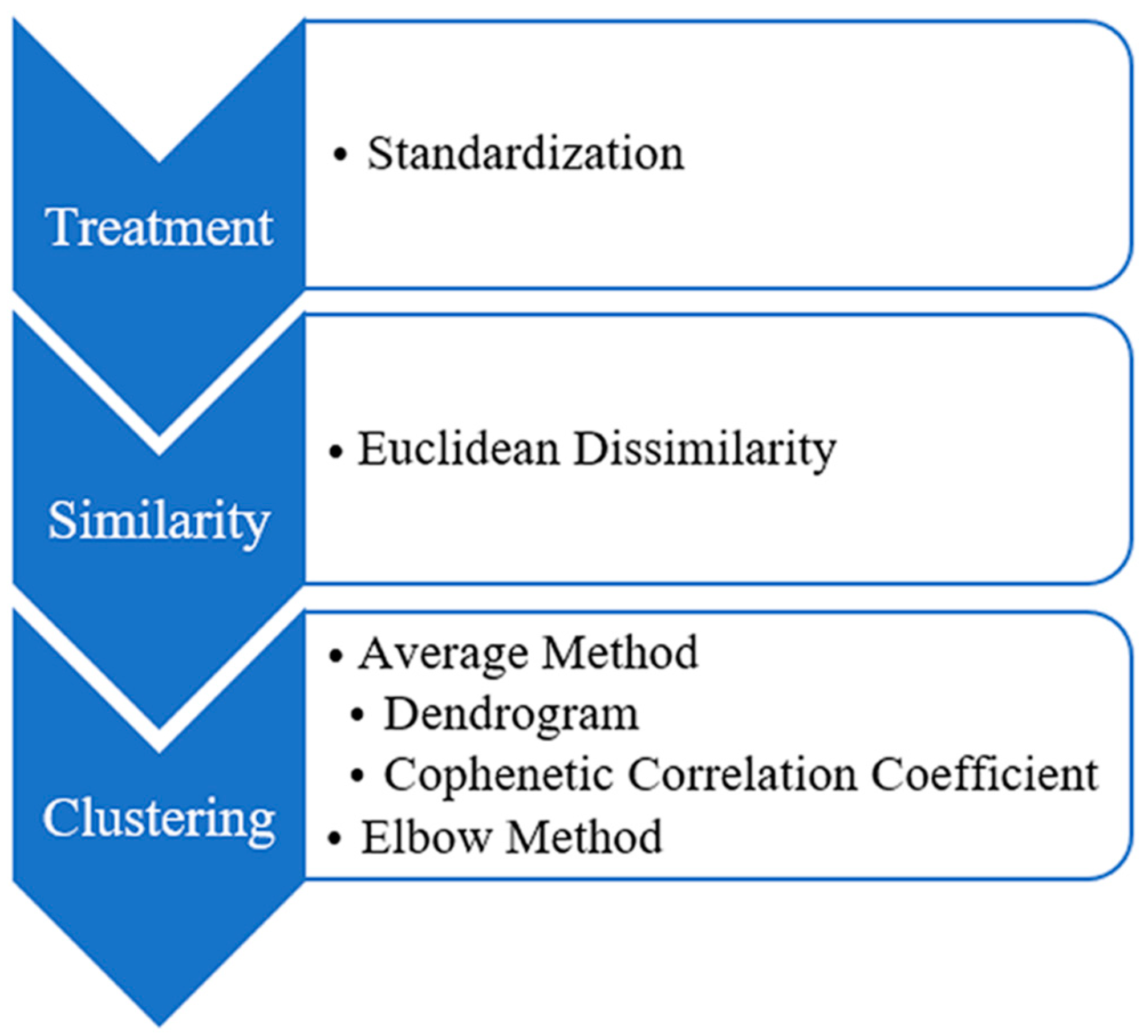

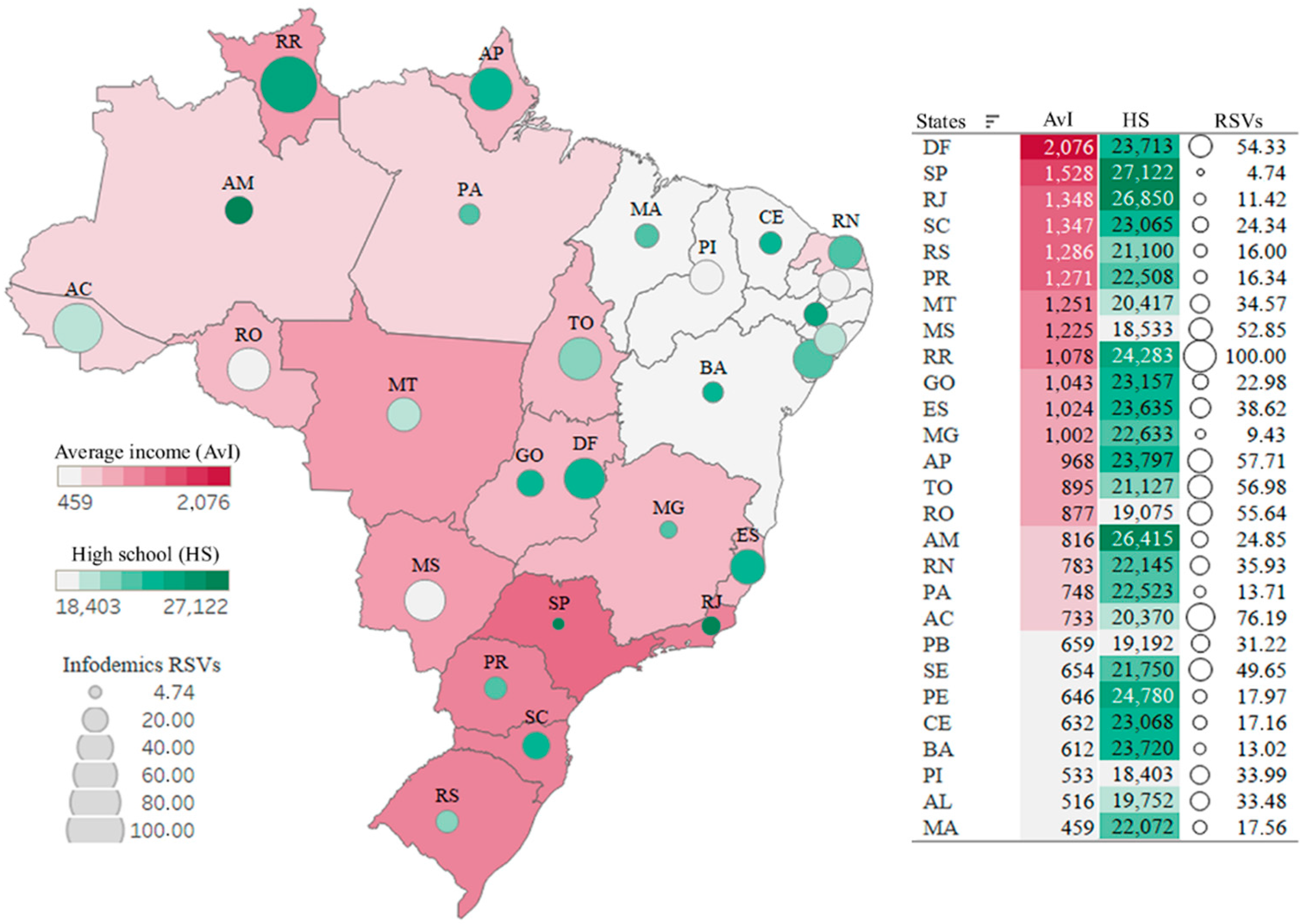
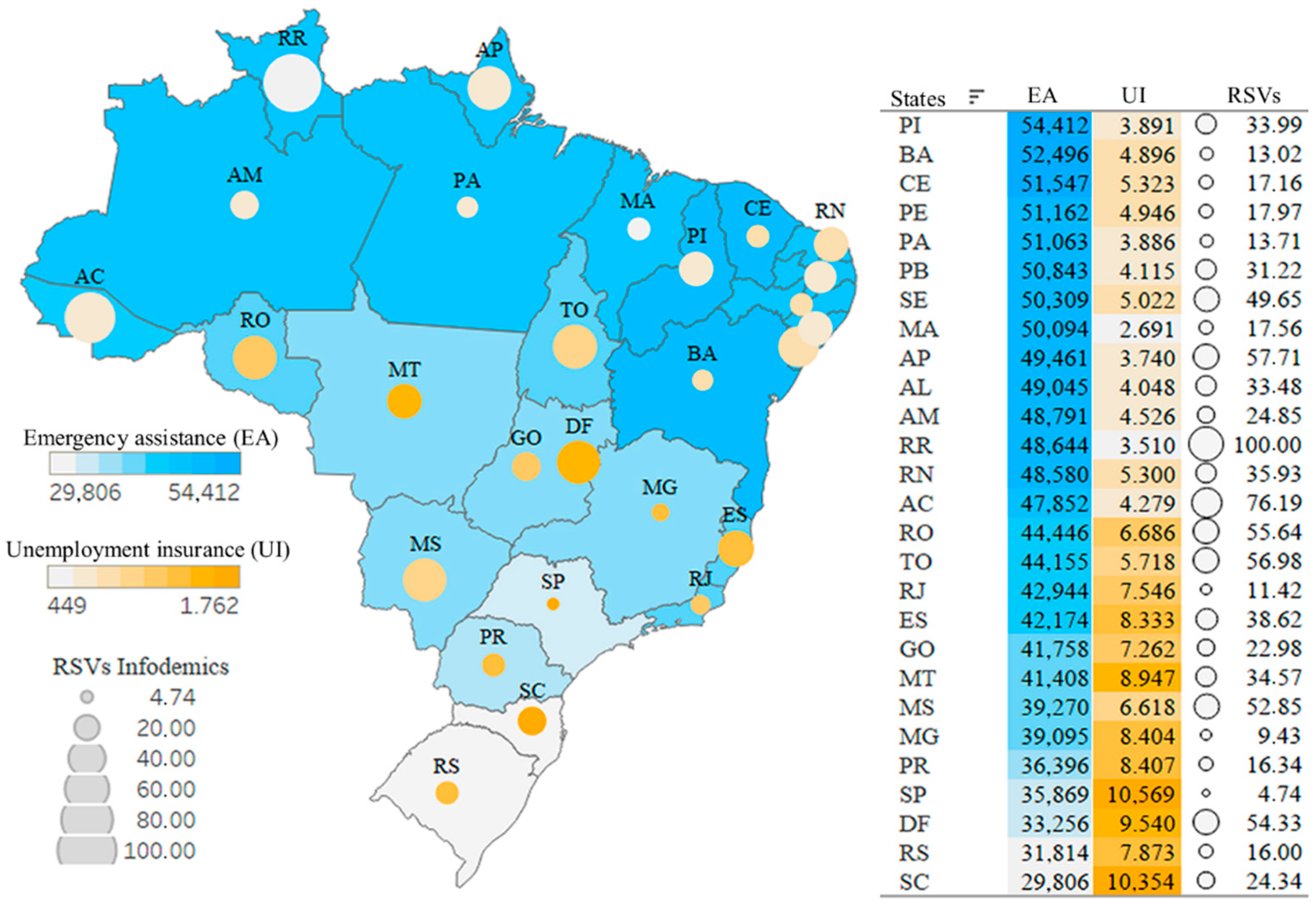


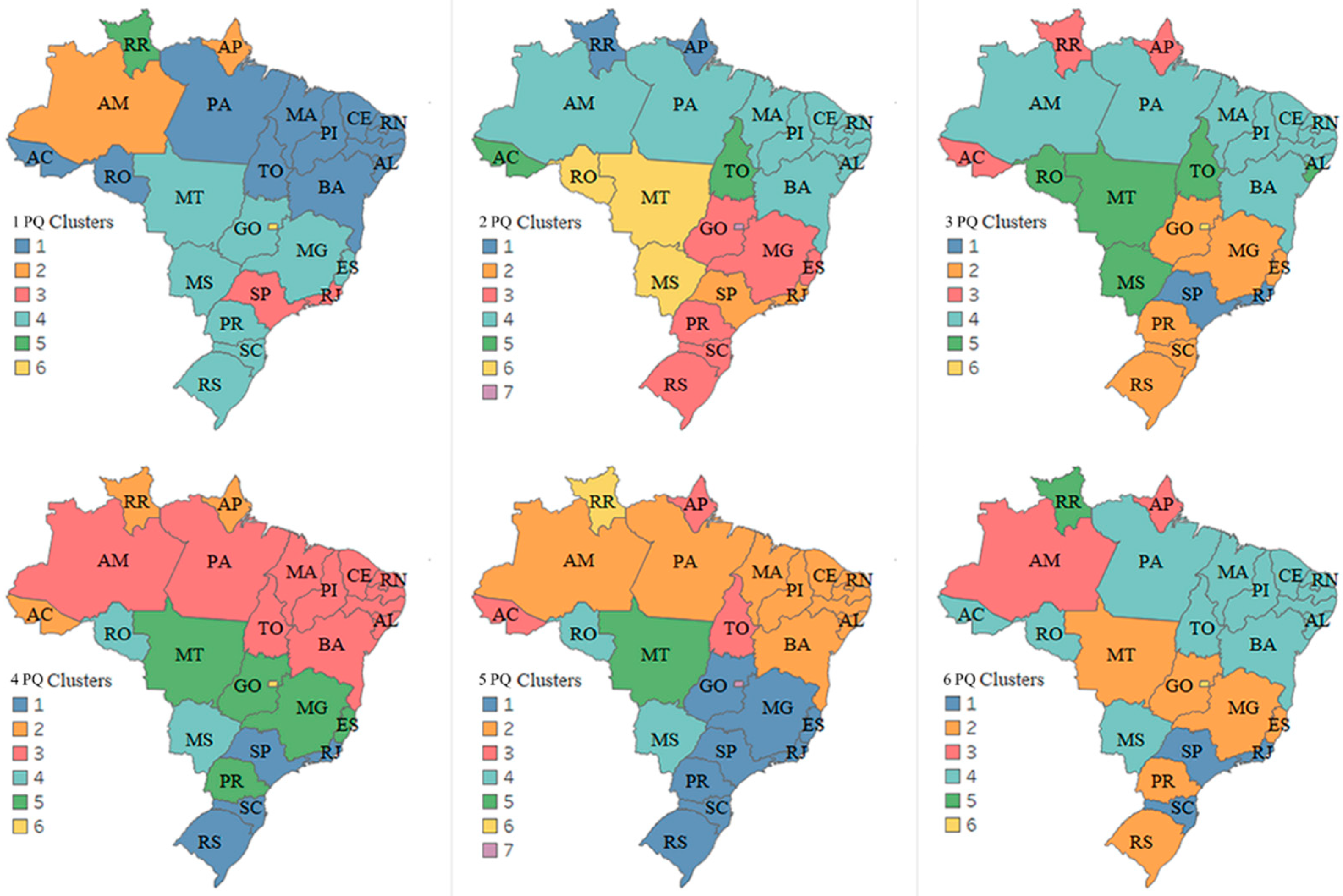
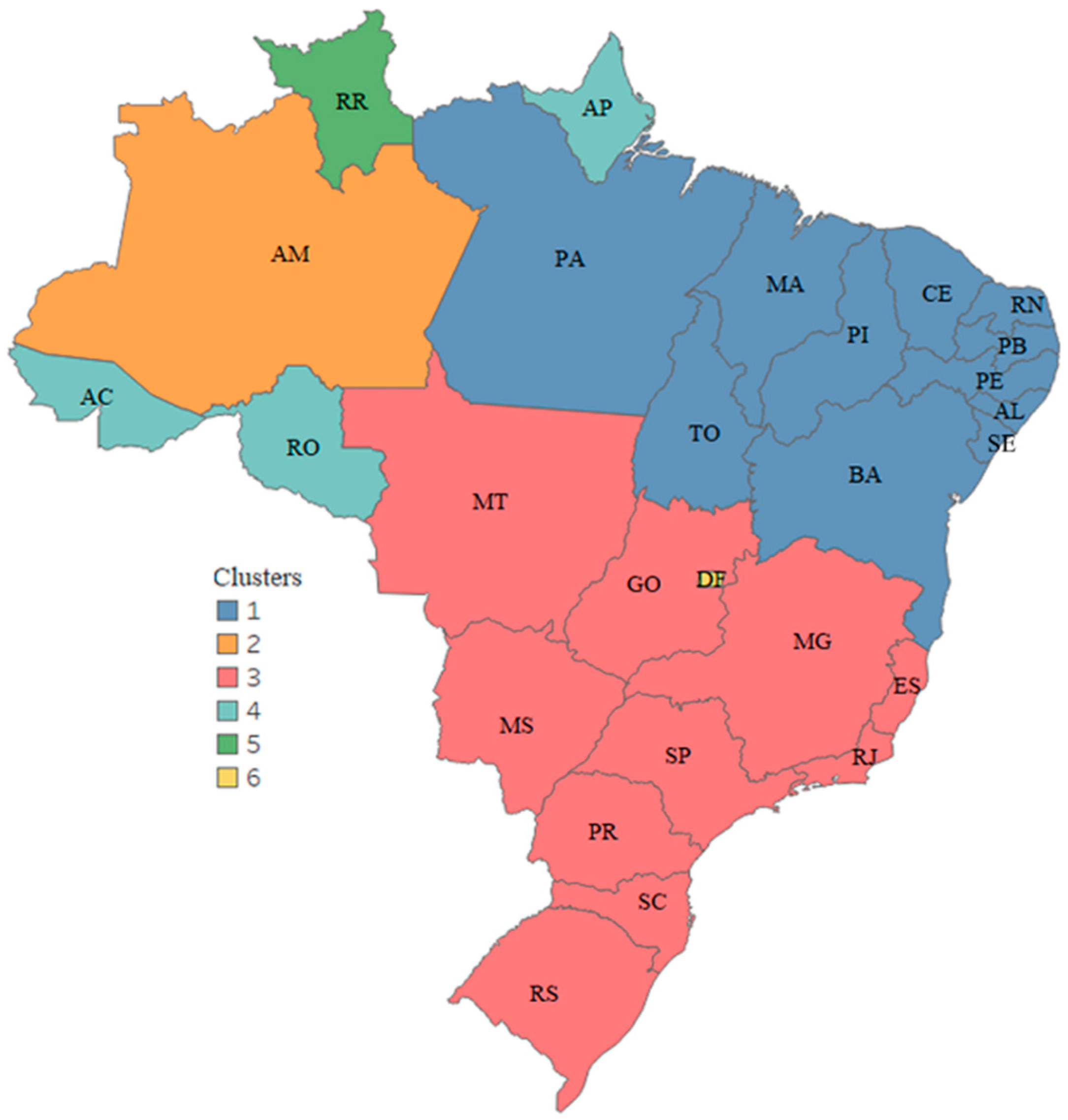
| Year | Period | Pandemic Quarters |
|---|---|---|
| 2020 | January to March | 1 PQ |
| April to June | 2 PQ | |
| July to September | 3 PQ | |
| Octorber to December | 4 PQ | |
| 2021 | January to March | 5 PQ |
| April to June | 6 PQ |
Publisher’s Note: MDPI stays neutral with regard to jurisdictional claims in published maps and institutional affiliations. |
© 2022 by the authors. Licensee MDPI, Basel, Switzerland. This article is an open access article distributed under the terms and conditions of the Creative Commons Attribution (CC BY) license (https://creativecommons.org/licenses/by/4.0/).
Share and Cite
Harb, M.d.P.d.A.A.; Silva, L.V.e.; Vijaykumar, N.L.; Silva, M.S.d.; Francês, C.R.L. An Analysis of the Deleterious Impact of the Infodemic during the COVID-19 Pandemic in Brazil: A Case Study Considering Possible Correlations with Socioeconomic Aspects of Brazilian Demography. Int. J. Environ. Res. Public Health 2022, 19, 3208. https://doi.org/10.3390/ijerph19063208
Harb MdPdAA, Silva LVe, Vijaykumar NL, Silva MSd, Francês CRL. An Analysis of the Deleterious Impact of the Infodemic during the COVID-19 Pandemic in Brazil: A Case Study Considering Possible Correlations with Socioeconomic Aspects of Brazilian Demography. International Journal of Environmental Research and Public Health. 2022; 19(6):3208. https://doi.org/10.3390/ijerph19063208
Chicago/Turabian StyleHarb, Maria da Penha de Andrade Abi, Lena Veiga e Silva, Nandamudi Lankalapalli Vijaykumar, Marcelino Silva da Silva, and Carlos Renato Lisboa Francês. 2022. "An Analysis of the Deleterious Impact of the Infodemic during the COVID-19 Pandemic in Brazil: A Case Study Considering Possible Correlations with Socioeconomic Aspects of Brazilian Demography" International Journal of Environmental Research and Public Health 19, no. 6: 3208. https://doi.org/10.3390/ijerph19063208
APA StyleHarb, M. d. P. d. A. A., Silva, L. V. e., Vijaykumar, N. L., Silva, M. S. d., & Francês, C. R. L. (2022). An Analysis of the Deleterious Impact of the Infodemic during the COVID-19 Pandemic in Brazil: A Case Study Considering Possible Correlations with Socioeconomic Aspects of Brazilian Demography. International Journal of Environmental Research and Public Health, 19(6), 3208. https://doi.org/10.3390/ijerph19063208






